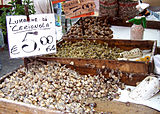Dredge oyster: Difference between revisions
rm copvio from Powell |
OBlackthorn (talk | contribs) citations added |
||
| Line 1: | Line 1: | ||
{{Taxobox |
{{Taxobox |
||
| name = '' |
| name = ''Ostrea chilensis''<br> the Chilean flat oyster or New Zealand Bluff oyster |
||
| image = |
| image = |
||
| image caption = |
| image caption = |
||
| Line 10: | Line 10: | ||
| familia = [[Ostreidae]] |
| familia = [[Ostreidae]] |
||
| subfamia = [[Ostreinae]] |
| subfamia = [[Ostreinae]] |
||
| genus = '''''[[ |
| genus = '''''[[Ostrea]]''''' |
||
| species = ''''' |
| species = '''''O. chilensis''''' |
||
| binomial = '' |
| binomial = ''Ostrea chilensis'' |
||
| binomial_authority = |
| binomial_authority = |
||
| synonyms = '' |
| synonyms = ''Tiostrea chilensis''<br>''Tiostrea lutaria'' |
||
}} |
}} |
||
''''' |
'''''Ostrea chilensis''''', the [[Chilean]] flat oyster known in [[New Zealand]] as the '''Bluff oyster''',<ref name="NZHerald10559582"/> is a species of [[marine (ocean)|marine]] [[bivalve]] [[mollusc]] in the [[family (biology)|family]] [[Ostreidae]]. |
||
==Distribution== |
==Distribution== |
||
'' |
''Ostrea chilensis'' is [[endemism|endemic]] to [[Chile]] and [[New Zealand]]. |
||
There is also a self-sustaining population in the [[Menai Strait]] which was accidentally introduced from the Fisheries Laboratory, Conwy, in 1965 or 1966 (sources disagree). |
There is also a self-sustaining population in the [[Menai Strait]] which was accidentally introduced from the Fisheries Laboratory, Conwy, in 1965 or 1966 (sources disagree). |
||
Currently, a significant number of distributional facts, particularly involving oceanic disjunctions of poor-dispersing taxa, are in direct conflict with [[Plate Tectoncs|conventional]] [[Cretaceous|paleomaps of the Mesozoic Pacific]] and [[Tethys Ocean|Tethys]]. Many researchers have dealt with these inconsistencies by ignoring basic [[biogeographical]] realities<ref>[http://www.systass.org/newsletter/TheSystematist25.pdf McCarthy, D.D., McCarthy, D.D., Biogeography and Scientific Revolutions, The Systematist, Number 25, Pages 3-12, 2005] and positing a radical cross-ocean [[raft|rafting]] dispersal hypothesis to explain the problematic disjunctions.<ref>[http://www.biolbull.org/cgi/content/citation/196/2/122 Foighil, D.O., et al., Trans-Pacific Range Extension by Rafting Is Inferred for the Flat Oyster Ostrea chilensis]</ref> |
|||
However, the flat oyster, Ostrea chilensis, does not have an extended pelagic phase<ref>[http://www.biolbull.org/cgi/content/citation/196/2/122 Foighil, D.O., et al., Trans-Pacific Range Extension by Rafting Is Inferred for the Flat Oyster Ostrea chilensis]</ref> suggesting [[Expanding Earth|alteranative tectonics theories]]. |
|||
==Habitat== |
==Habitat== |
||
Revision as of 03:51, 22 March 2009
| Ostrea chilensis the Chilean flat oyster or New Zealand Bluff oyster | |
|---|---|
| Scientific classification | |
| Kingdom: | |
| Phylum: | |
| Class: | |
| Subclass: | |
| Order: | |
| Family: | |
| Genus: | |
| Species: | O. chilensis
|
| Binomial name | |
| Ostrea chilensis | |
| Synonyms | |
|
Tiostrea chilensis | |
Ostrea chilensis, the Chilean flat oyster known in New Zealand as the Bluff oyster,[1] is a species of marine bivalve mollusc in the family Ostreidae.
Distribution
Ostrea chilensis is endemic to Chile and New Zealand.
There is also a self-sustaining population in the Menai Strait which was accidentally introduced from the Fisheries Laboratory, Conwy, in 1965 or 1966 (sources disagree).
Currently, a significant number of distributional facts, particularly involving oceanic disjunctions of poor-dispersing taxa, are in direct conflict with conventional paleomaps of the Mesozoic Pacific and Tethys. Many researchers have dealt with these inconsistencies by ignoring basic biogeographical realitiesCite error: A <ref> tag is missing the closing </ref> (see the help page).
However, the flat oyster, Ostrea chilensis, does not have an extended pelagic phase[2] suggesting alteranative tectonics theories.
Habitat
This bivalve is found from low tide to depths of up to 35 m.
Description
Height is up to 105 mm, width up to 70 mm, and inflation up to 33 mm.
Commercial importance
In New Zealand they are a prized delicacy, and harvested from March to August from the Foveaux Strait oyster fishery.[1] From the early 1980s the fishery went into serious decline, due to the outbreak of an oyster parasite Bonamia exitosa, the disease killing an estimated billion oysters between 2000 and 2003.[1] The population has been recovering since 2003, with fishermen voluntarily limiting the catch to half the allowable to aid the revival.[1]
Other
There is some speculation that with the change in river flows in Southland due to farming and especially power generation, this has amounted to lower flows of fresh water carrying limestone deposits into the Strait. This therefore is believed by some to have amounted to increase of susceptibility to Bonamia as well as lower growth rates for some seasons in the past. As of yet there is little evidence to support it and as such only seems coincidental.
References
- ^ a b c d "High demand for recession-proof oysters". New Zealand Herald. 2 March 2009. Retrieved 2009-03-02.
- ^ Foighil, D.O., et al., Trans-Pacific Range Extension by Rafting Is Inferred for the Flat Oyster Ostrea chilensis


